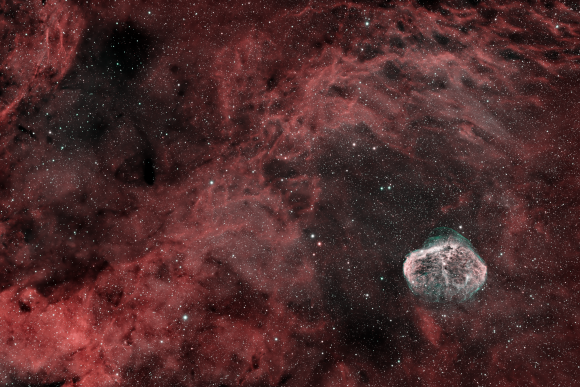NGC 6888, also known as The Crescent Nebula, is a faint emission nebula in the constellation Cygnus. This nebula is about 5000 light-years away. I like calling this The Horseshoe Crab Nebula. It is formed from swift stellar wind from two stars colliding about 250,000 to 400,000 years ago, resulting in a shell and two shock waves.
This is also known as the “Euro sign nebula” due to its shape. My niece also likes calling this the space brain.
 Click on this image to see the Crescent Nebula zoomed in.
Click on this image to see the Crescent Nebula zoomed in.
 Here you can see the area of the sky in Cygnus imaged.
Here you can see the area of the sky in Cygnus imaged.
I was somehow able to get 4 clear nights and got some Ha and Oiii data on this target. I wanted to get some RGB data for star color, but I haven’t had any clear skies since I captured this target.
I had 84 Oiii and 49 Ha frames that I was able to stack and calibrate in PixInisight.
Processing Info
The following steps were performed with the Ha and Oiii data:
-
- Dynamic Crop
- Linear Fit
- Dynamic Backgroud Extraction
- TGV Denoise
- Multiscale Median Transform
I combined the channels in a HOO palette with the following Pixelmath formula:
-
- R: Ha
- G: (0.2*Ha)+(0.8*Oiii)
- B: (0.2*Ha)+(0.8*Oiii)
The following steps were performed to the resulting color image:
-
- Background Neutralization
- Color Calibration
- Histogram Transformation
- LRGB Combination
- Curves Transformation (x2 with multiple range masks)
- Curves Transformation (Using brightness mask created with the GAME Script)
- Local Histogram Transformation
- SCNR (Removed green)
- Starnet++
- Morphological Transformation (Star reduction)
Once I was happy with the resulting image, I was able to take it to photoshop for final watermarking and some hue and vibrace adjustments.
Acquisition Data
- Telescope: Explore Scientific FCD100 Series 127mm f/7.5 Carbon Fiber Triplet ED APO Refractor Telescope
- Camera: ZWO ASI2600MM Pro, 100 Gain, -10°C
- Guiding: ZWO Off-Axis Guider with Helical Focuser
- Guide Camera: ZWO ASI290MM Mini. Dithering every image at 1 pixel each time.
- Mount: iOptron CEM60
- Software: SGP for image acquisition. PixInsight is used for stacking and editing. Imported to Photoshop for final touchup and watermarking.
- Other Accessories: Dew-Not Dew Heater, Starizona 0.65x Apex-L Focal Reducer/Flattener, MoonLite NiteCrawler Rotating Focuser, PrimaLuceLab Eagle 4S
- Filters:
- Chroma 36mm Ha 5nm (49 x 300s)
- Chroma 36mm Oiii 5nm (84 x 300s)
- Exposure Time: 11 hours 5 minutes
- Date: July, 31, August 01, 02, & 03, 2021
- Location: Voorhees State Park, NJ
- Bortle Dark-Sky Scale: 4
- Mean SQM: 19.82
- RA center: 20h 12′ 58″
- DEC center: +38° 56′ 33″
- Orientation: -47.091 degrees
- Field radius: 1.247 degrees
- Magnitude: 7.4
- Resolution: 3720 x 2330
I acquired this image over two consecutive nights. Night one I took about 40 frames at 240 seconds, out of which I was only able to use 21 due to clouds. The second night I took 30 frames at 300 seconds. I had to throw one out due to airplane trails. This was taken through an Optolong L-Pro filter.
Processing Info
I stacked the 50 light frames along with 40 dark and flat frames. I had registered and each night’s pictures the previous morning and then stacked them all together at the end of the second night
The following processes were performed in PixInsight:
- Dynamic Crop
- Dynamic Background Extraction
- Automatic Background Extraction
- Background Neutralization
- Photometric Color Calibration
- Histogram Transformation
- Curves Transformation
- HDR Multiscale Transformation
- ACDNR (Noise Reduction)
- StarMask
Once I found what I liked, I saved the files and went to Photoshop, and ran Topaz AI DeNoise. This is an amazing plugin that works like magic.
Acquisition Data
- Telescope: Explore Scientific ED127 Air-Spaced Triplet Apochromatic Refractor
- Camera: ASI071MC Pro
- Guide Scope: Orion ST80
- Guide Camera: ASI290MM Mini. Dithering every image at 1 pixel each time.
- Mount: iOptron CEM60
- Software: Image acquisition using N.I.N.A. PixInsight for stacking and editing, Photoshop for final editing along with Topaz DeNoiseAI for noise reduction.
- Other Accessories: AstroZap Dew Heater, Explore Scientific 2″ Field Flattener, ZWO EAF motorized focuser.
- Filters: Optolong L-Pro 2″
- Exposure Time: 229 minutes over two nights (21 X 240 seconds and 29 x 300 seconds). Gain 90, -10°C bin 1×1
- Exposure Start: 22:17
- Location: Glassboro, NJ, United States
- GPS Coordinates: Lat. 39.702774° N, Long. -75.11195° E
- Temperature: 65°F/18.3°C
- Bortle Dark-Sky Scale: 5
- Astrometry.net job: 3627097
- Avg. Moon age: 22.80 Days
- Avg. Moon phase: 43.12%
- RA center: 20h 12′ 6″
- DEC center: +38° 21′ 18″
- Orientation: 222.733 degrees
- Field radius: 0.631 degrees
- Magnitude: 7.4
- Resolution: 3720 x 2330


